Sling - Synthetic round sling:
Synthetic round slings offer a number of advantages for rigging purposes. The most commonly used synthetic round slings are made of nylon- or polyester-type yarns. They have the following properties in common:
- Strength,
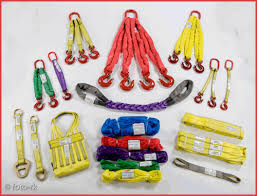
- Convenience,
- Load protection, and
- Economy.
Each synthetic material has its own unique properties. Certain synthetic materials perform better than others in specific applications and environments. Consult the sling manufacturer or a qualified person for a specific application or before using in and around chemical environments.
Some round slings are manufactured using materials other than nylon or polyester; consult the manufacturer for the proper selection, use, maintenance, and any hazards associated with their use.
Identification:
New slings are marked by the manufacture to show:
- The rated load for the types of hitches, and the angle upon which they are based,
- The core material, and
- The cover material if different from core material.
In addition, slings may be marked to show:
- The name or trademark of the manufacturer,
- The manufacturer's code or stock number, and
- The name or trademark of the manufacturer.
Rated loads:
Rated loads (capacities) for single-leg vertical, choker, basket hitches, and two-leg bridle slings are as shown in Table 26.
For angles not shown, use the next lower angle or a qualified person to calculate the rated load. Rated loads are based on: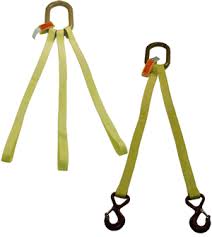
- Material strength,
- Design factor,
- Type of hitch,
- Angle of loading (see Fig. 3), and
- Diameter of curvature over which the sling is used.
Do not use horizontal angles less than 30 degrees except as recommended by the sling manufacturer or a qualified person.
The rated load for a sling in a choker hitch is the value in Table 26, provided that the angle of the choke is 120 degrees or more (see Fig. 2). For angles of choke less than 120 degrees, use the rated loads provided by the sling manufacturer or a qualified person.
For other synthetic round sling materials and for configurations not shown, use the rated loads provided by the sling manufacturer or a qualified person.
Fig-2 Fig-3
Fittings:
Ensure that mechanical fittings used as part of a synthetic round sling meet the following:
- Materials are compatible with the mechanical and environmental requirements of the sling,
- Fittings have a rated load at least the same as the round sling,
- Fittings have sufficient strength to sustain twice the rated load of the sling without visible permanent deformation, and
- Surfaces are clean, and sharp edges are removed.
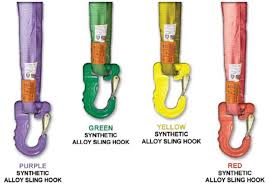
Inspections:
Designate a qualified person to inspect slings and all fastenings and attachments each day before use for damage or defects.
This qualified person also performs additional periodic inspections where service conditions warrant, as determined on the basis of:
- Frequency of sling use,
- Severity of service conditions,
- Nature of lifts being made, and
- Experience gained during the service life of slings used in similar circumstances.
Make periodic inspections of synthetic round slings at intervals no greater than 12 months. A good guide to follow includes:
- Yearly for normal service use,
- Monthly to quarterly for severe service, and
- As recommended by a qualified person for special and infrequent service use.
Although OSHA's sling standard does not require you to make and maintain records of inspections, the ASME standard contains provisions on inspection records.
Table 26
Rated Load for Single-Leg Polyester Round slings:
Endless and Eye-and Eye Type
Expressed in Pounds
GENERAL NOTES:
(a) Round slings are identified by the vertical rated load shown on the sling identification. The size numbers in the first column have been adopted by the Web Sling & Tie Down Association to describe certain polyester round slings. They are included for references only. Other polyester round slings may have different vertical rated loads.
(b) Color guidelines for polyester round sling covers are widely used to indicate the vertical rated load of round slings; however, this is not followed by some manufacturers. Always select and use round slings by the rated load as shown on the sling identification; never by color.
(c) For choker hitch, the angle of choke is 120 deg or greater.
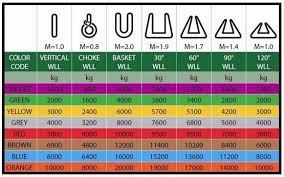
Make a thorough inspection of slings and attachments. Items to look for include:
- Missing or illegible sling identification,
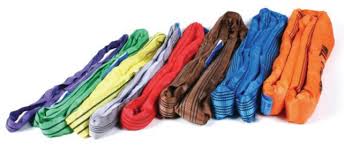
- Acid or caustic burns,
- Evidence of heat damage,
- Holes, tears, cuts, abrasive wear, or snags, that expose the core yarn,
- Broken or damaged core yarns,
- Welding splatter that exposes core yarns,
- Knots in the round sling body, except for core yarn knots inside the cover,
- Discoloration and brittle or stiff areas on any part of the sling,
- Pitted, corroded, cracked, bent, twisted, gouged, or broken fittings, and
- Other conditions that cause doubt as to the continued use of the sling.
Where any such damage or deterioration is present, remove the sling or attachment from service immediately.
Fig. 6 D/d Ratio
Type I
Sling made with a triangle fitting on one end and a slotted triangle choker fitting on the other end. It can be used in a vertical, basket, or choker hitch.
Type II
Sling made with a triangle fitting on both ends. It can be used in a vertical or basket hitch only.
Type III
Sling made with flat loop eye on each end with loop eye opening on same plane as sling body. This type of sling is sometimes called a flat eye-and-eye, eye-and-eye, or double-eye sling.
Type IV
Sling made with both loop eyes formed as in Type III, except that the loop eyes are turned to form a loop eye which is at a right angle to the plane of the sling body. This type of sling is commonly referred to as a twisted-eye sling.
Type V
Endless sling, sometimes referred to as a grommet. It is a continuous loop formed by joining the ends of the webbing together.
Type VI
Return-eye (reversed-eye) sling is formed by using multiple widths of webbing held edge-to-edge. A wear pad is attached on one or both sides of the sling body and on one or both sides of the loop eyes to form a loop eye at each end which is at a right angle to the plane of the sling body
Repairing/Reconditioning:
Do not use worn or damaged slings or attachments. Discard or repair them. Use damaged slings only after they are repaired, reconditioned, and proof tested by the sling manufacturer or a qualified person using the following criteria:
- Ensure that the manufacturer or a qualified person performs repairs,
- Ensure that repairs of hooks and fittings meet ASME B30.10 and B30.26,
- Do not repair cracked, broken, melted, or damaged fittings or attachments,
- Do not repair melted or damaged internal yarns,
- Do not make any temporary repairs of round slings or fittings, and
- Mark repaired slings to identify who made the repairs.
Operating practices:
Ensure that synthetic round slings have suitable characteristics for the type of load, hitch, and environment in which they will be used and that they are not used with loads in excess of the rated load capacities described in the appropriate tables. Consult the sling manufacturer for slings not included in the table. Follow other safe operating practices, including:
Sling Selection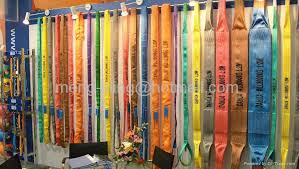
- For multiple-leg slings used with non symmetrical loads, ensure that an analysis by a qualified person is performed to prevent overloading of any leg,
- Ensure that multiple-leg slings are selected according to Table 26 when used at the specific angles given in the table. Ensure that operations at other angles are limited to rated loads of the next lower angle given in the table or calculated by a qualified person, and
- Ensure that the fitting is the proper shape and size to ensure that it is seated properly in the hook or lifting device.
Cautions to Personnel:
- Ensure that all portions of the human body are kept away from the areas between the sling and the load and between the sling and the crane or hoist hook,
- Ensure that personnel never stand in line with or next to the legs of a sling that is under tension,
- Ensure that personnel do not stand or pass under a suspended load,
- Ensure that personnel do not ride the sling or the load, unless the load is specifically designed and tested for carrying personnel, and
- Do not use synthetic round slings as bridles on suspended personnel platforms.
Effects of Environment:
- Store slings in an area where they will not be subjected to mechanical, chemical, or ultraviolet damage, or to extreme temperatures, and
- When slings are exposed to extreme temperatures, follow the guidance provided by the sling manufacturer or qualified person.

Rigging Practices:
- Ensure that slings are hitched in a manner providing control of the load,
- Ensure that sharp edges in contact with slings are padded with material of sufficient strength to protect the sling,
- Ensure that slings are shortened or adjusted only by methods approved by the sling manufacturer or a qualified person,
- Ensure that, during lifting with or without a load, personnel are alert for possible snagging,
- Ensure that, in a basket hitch, the load is balanced to prevent slippage,
- When using a basket hitch, ensure that the legs of the sling contain or support the load from the sides, above the center of gravity, so that the load remains under control,
- Ensure that, in a choker hitch, the choke point is only on the sling body, never on a splice or fitting,
- Ensure that, in a choker hitch, an angle of choke less than 120 degrees is not used without reducing the rated load,
- Ensure that slings are not constricted, bunched, or pinched by the load, hook, or any fitting,
- Ensure that the load applied to the hook is centered in the base (bowl) of the hook to prevent point loading on the hook, unless the hook is designed for point loading,
- Ensure that an object in the eye of a sling is not wider than one-third the length of the eye,
- Do not shorten or lengthen a sling by knotting or twisting,
- Do not rest loads on the sling,
- Do not pull a sling from under a load when the load is resting on the sling,
- Do not drag slings on the floor or over abrasive surfaces,
- Do not allow shock loading, and
- Avoid twisting and kinking.
Proof testing: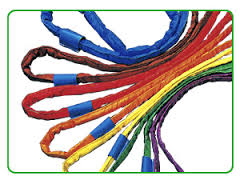
- Before initial use, ensure that all synthetic round slings incorporating previously used or welded fittings are proof tested by the manufacturer or a qualified person.
- Other new synthetic round slings and fittings need not be proof tested, although the employer may require proof testing in purchasing specifications.
Environmental effects:
Temperature
Do not allow polyester round slings to be used in contact with objects or at temperatures in excess of 194 degrees F (90 degrees C), or below minus 40 degrees F (minus 40 degrees C).
Some synthetic yarns do not retain their breaking strength during long-term exposure above 140 degrees (60 degrees C). Consult the sling manufacturer for the effects of long-term heat exposure.
Sunlight & Ultraviolet:
Long-term exposure to sunlight or ultraviolet radiation can affect the strength of polyester round slings. Consult the sling manufacturer for proper retirement criteria for polyester round slings subjected to long-term storage or use in sunlight.
Chemical
Chemically active environments can affect the strength of synthetic round slings. Consult the manufacturer before using a sling in such environments.
Ensure that in chemically active environments the cover is the same yarn as the load-bearing core.
Click the below link to download the inspection form for synthetic round sling

Inspection form - Synthetic Round sling